
The Blarney Stone is a block of Carboniferous limestone built into the battlements of Blarney Castle, Blarney, about 8 kilometres from Cork, Ireland. According to legend, kissing the stone endows the kisser with the gift of the gab. The stone was set into a tower of the castle in 1446. The castle is a popular tourist site in Ireland, attracting visitors from all over the world to kiss the stone and tour the castle and its gardens.

The Pena Palace is a Romanticist castle in São Pedro de Penaferrim, in the municipality of Sintra, on the Portuguese Riviera. The castle stands on the top of a hill in the Sintra Mountains above the town of Sintra, and on a clear day it can be easily seen from Lisbon and much of its metropolitan area. It is a national monument and constitutes one of the major expressions of 19th-century Romanticism in the world. The palace is a UNESCO World Heritage Site and one of the Seven Wonders of Portugal. It is also used for state occasions by the President of the Portuguese Republic and other government officials.

The term Norman architecture is used to categorise styles of Romanesque architecture developed by the Normans in the various lands under their dominion or influence in the 11th and 12th centuries. In particular the term is traditionally used for English Romanesque architecture. The Normans introduced large numbers of castles and fortifications including Norman keeps, and at the same time monasteries, abbeys, churches and cathedrals, in a style characterised by the usual Romanesque rounded arches and especially massive proportions compared to other regional variations of the style.
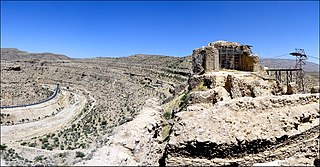
Qal'eh Dokhtar, Ghale Dokhtar , Dezh Dokhtar, is a castle made by Ardashir I, in present-day Fars, Iran, in 209 AD. It is located on a mountain slope near the Firouzabad-Kavar road.

Portknockie is a coastal village on the Moray Firth within Moray, Scotland.

Romanesque Revival is a style of building employed beginning in the mid-19th century inspired by the 11th- and 12th-century Romanesque architecture. Unlike the historic Romanesque style, however, Romanesque Revival buildings tended to feature more simplified arches and windows than their historic counterparts.
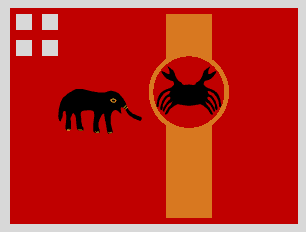
The Central Region is one of the ten administrative regions of Ghana. It is bordered by Ashanti and Eastern regions to the north, Western region to the west, Greater Accra region to the east, and to the south by the Gulf of Guinea. The Central region is renowned for its many elite higher education institutions and an economy based on an abundance of industrial minerals and tourism. The Central region attains many tourist attractions such castles, forts and beaches stretched along the Central region's coastline.
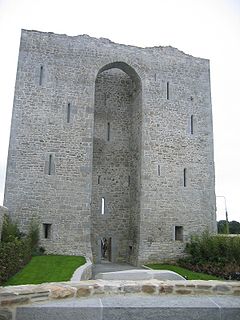
The last bastion against Queen Elizabeth I in the First Desmond Rebellion, Listowel Castle was built in the 15th century and was the last fortress of the Geraldines to be subdued. It fell after 28 days siege to Sir Charles Wilmot on 5 November 1600, who had the castle's garrison executed in the following days. One of the best examples of Anglo-Norman architecture in County Kerry, the castle has now been restored to some of its former glory. The castle is open to the public for tours on a daily basis.
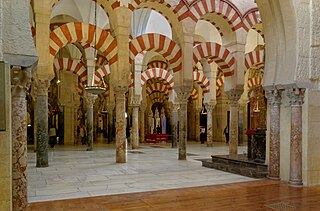
Moorish architecture is the articulated Islamic architecture of North Africa and parts of Spain and Portugal, where the Andalusians (Moors) were dominant between 711 and 1492. The best surviving examples are La Mezquita in Córdoba and the Alhambra palace in Granada, as well as the Giralda in Seville (1184). Other notable examples include the ruined palace city of Medina Azahara (936–1010), the church San Cristo de la Luz in Toledo, the Aljafería in Saragossa and baths at for example Ronda and Alhama de Granada.
The College of Design at the Georgia Institute of Technology, established in 1908 as the Department of Architecture and also formerly called the College of Architecture, offered the first four-year course of study in architecture in the Southern United States.

New Castle County Vocational-Technical School District is a public vocational-technical school district serving New Castle County, Delaware. Its headquarters are located at Delcastle Technical High School, in an unincorporated area in the county.

Black Castle Public House is a Grade I-listed building and public house on Junction Road in the Brislington suburb of the English city of Bristol. It is also known as Arno's Castle.

Arno's Court Triumphal Arch is in Junction Rd, Brislington, Bristol, England.
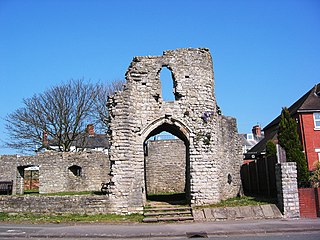
Barry Castle is a small Grade II* listed ruined two-storey gatehouse with the adjacent walls of a hall located in the Romilly district of Barry, Vale of Glamorgan in south Wales. The Norman castle was really little more than a small fortified manor house, the seat of the de Barry family, which was built in the 13th and 14th centuries to replace an earlier earthwork.

The Royal Arch or Victoria Arch was a structure erected in Dundee, Scotland, between 1849 and 1853 and demolished in 1964. The monumental archway formerly stood over the access to the pier between Earl Grey Dock and King William IV Dock on the city's waterfront.

Eaucourt-sur-Somme is a commune in the Somme department in Hauts-de-France in northern France.

Rufus Castle, also known as Bow and Arrow Castle, is a partially ruined castle overlooking Church Ope Cove on Portland, England. Its name derives from King William II, known as William Rufus, after whom the original castle was built.
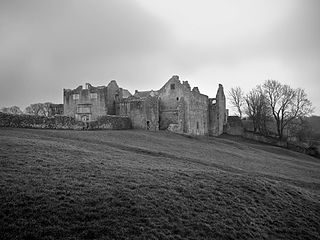
Old Beaupre Castle is a ruined medieval fortified manor house located in the community of Llanfair, outside Cowbridge in Wales. It is known in historic documents under the names Beawpire, Bewerpere, Bewpyr and Y Bewpur. It is a Grade I listed building and is presently under the care of Cadw. It can be visited free of charge all year round by members of the public.

Castle Forbes is a 19th-century country house in the Scottish baronial architecture style near Alford in Aberdeenshire, Scotland.

Dough Castle is a ruined tower house at Lahinch in County Clare, western Ireland. It was established by the O'Conors in the early 14th century, but nothing remains of the original structures.
























